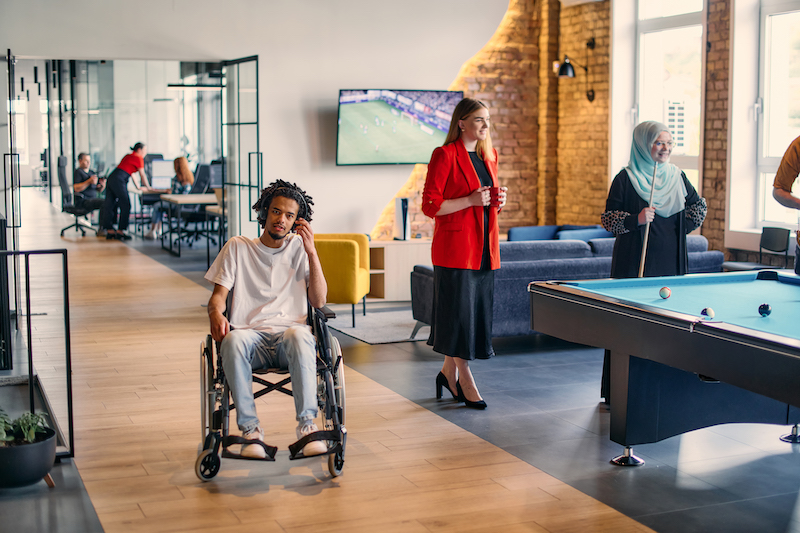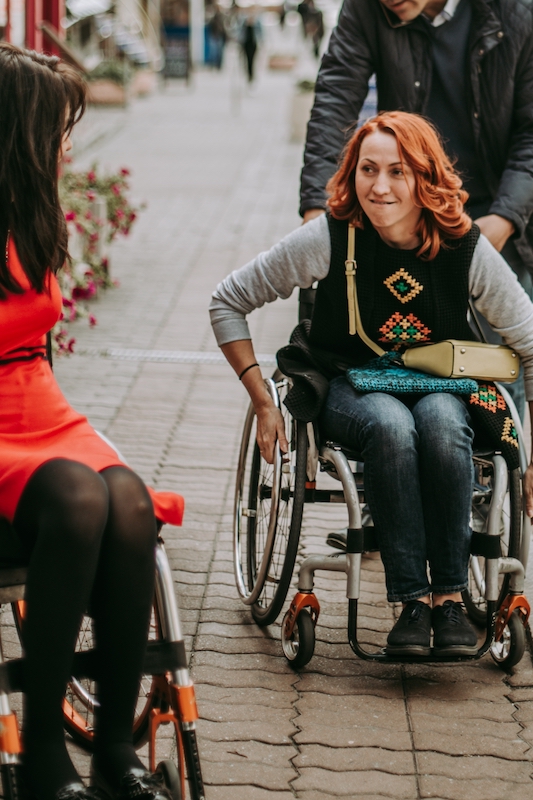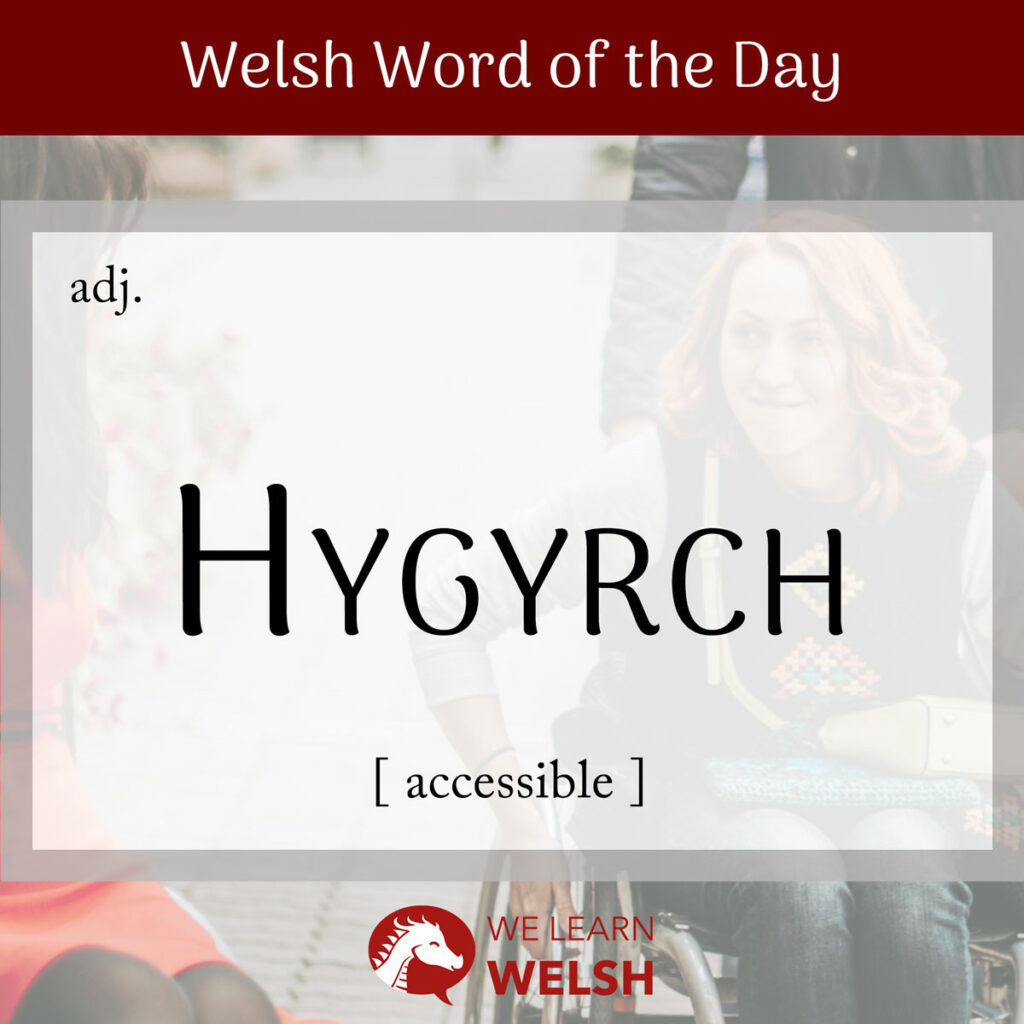Something very important to consider when designing buildings, planning events, or creating resources is accessibility. This means generally how easy and convenient it is for people to make use of what you’re creating, but it’s often used specifically to refer to accessibility for disabled people. The Welsh word for accessible is hygyrch.
hygyrch
accessible
The root of this word is cyrch, a noun which actually originally meant attack or assault, as well as, secondarily, a place to go to.
Cyrch evolved into the word cyrchu, which means to go towards or to access as well as to attack. Most of cyrch and cyrchu’s etymological descendants, like hygyrch, relate more to the theme of going somewhere than to violence of any kind. Other examples include cyrchfan (destination), cyrchnod (goal), cyrchfraint (right of access) and uniongyrchol (direct).
The prefix hy-, when added to verbs, indicates that something is possible or easy – for example hyblyg means flexible, since plygu is to fold. So hygyrch literally means easy to go towards.
There are a few useful, basic related terms derived from hygyrch, including:
- anhygyrch = inaccessible
- yn hygyrch = accessibly
- hygyrchedd = accessibility
- hygyrchu = to access frequently
Happily, hygyrch is one of those few Welsh words that always stays the same. It doesn’t vary depending on the gender or number of the noun that it’s used to describe, and it’s also not susceptible to mutations or to h-prosthesis.
Gallai hyn wneud yr amgueddfa’n fwy hygyrch.
This could make the museum more accessible.
This word hasn’t always been widely used, as the general idea of a place being easy to reach or something being accessible is more commonly expressed through phrases.
For example, you might say lle o fewn cyrraedd (a place within reach) to indicate that a location is physically accessible for a visit, or describe an item that is easy to pick up and use as wrth law (at hand).
As disability has become a better-understood topic, the word hygyrch has seen more frequent use in Welsh in recent years. For example, you might encounter the term when describing teithiau cerdded (walks) that are hygyrch for people using a cadair olwyn (wheelchair) or adnoddau addysgu (educational resources) designed for children with anableddau dysgu (learning difficulties).
Some things you might hope are hygyrch and not anhygyrch, particularly if they need to be used or accessed by a wide variety of people, include:
- adeiladau = buildings; adeilad hygyrch = an accessible building
- digwyddiadau = events; digwyddiad hygyrch = an accessible event
- cerbydau = vehicles; cerbyd hygyrch = an accessible vehicle
- llyfrau = books; llyfr hygyrch = an accessible book
- technoleg = technology; technoleg hygyrch = accessible tech
- meddalwedd = software; meddalwedd hygyrch = accessible software
Often, hygyrchedd (accessibility) can be improved through addasiadau rhesymol (reasonable adjustments). These might include allowing a student with anableddau dysgu (learning difficulties) extra time in an arholiad (exam) or enabling an employee with frequent disability-related apwyntiadau (appointments) to work flexible hours.
Ydy’r adeilad yn hygyrch?
Is the building accessible?

It’s also common for pobl anabl (disabled people) to use various kinds of technoleg gynorthwyol (assistive technology), like cymhorthion clywed (hearing aids). An important part of hygyrchedd is ensuring that buildings and events are organised such that people will be able to easily use their technoleg gynorthwyol.
Of the four countries in the UK, Cymru (Wales) has the highest percentage population of pobl anabl (disabled people). The COVID-19 pandemic has made many aspects of daily life even less hygyrch than they were before for people with anableddau (disabilities) and clefydau cronig (chronic illnesses).
Organisations like Anabledd Cymru (Disability Wales) and Anabledd Dysgu Cymru (Learning Disability Wales) lobby the llywodraeth (government) to encourage the introduction of deddfwriaeth (legislation) to empower, protect and support pobl anabl.
And of course, there are things we can all do to make the language learning community more hygyrch – like including is-deitlau (subtitles) on videos, and recommending a range of resources that suit different learning styles and abilities.
Here at We Learn Welsh we want to encourage as many people to learn y Gymraeg (Welsh) as possible, so if there’s anything we can do to make our content mwy hygyrch (more accessible) for you, let us know!


